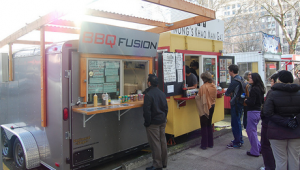Once thought to be an anomaly relegated to roam the earth in the form of a “roach coach,” food trucks are now the next culinary trend, suddenly everywhere: decorating the coastal regions of the eastern seaboard, dotting the landscape of the central plains and mountains, and coloring the beach towns along the west coast. Young chefs and culinary newcomers use the food truck to push food into novel and unique directions, offering anything and everything, from authentic global dishes to cuisine that merges ethnic flavors, and even to offering sustainable, farm-to-table fare. No food items are off limits in the culinary world of food carts.
The history of the food truck actually dates back to the Texas chuckwagon of the late 1800s, when a Texas cattle rancher utilized an old US Army wagon to bring food to the ranch hands who herded cattle from the southwest to sell at market in the northern and eastern parts of the United States. Later, food trucks could be seen at construction sites, feeding hungry workers with limited time for lunching. And who could forget chasing down the ice cream truck during childhood?

Food trucks gained in popularity during the last recession. Photo credit: Stu Spivack
The uprising of food carts was born as the downward trend of our nation’s economy during the last recession found people losing their jobs and/or without expendable income for dining in restaurants during lunch hours. Eager entrepreneurs jumped on the bandwagon, ready to earn an income without investing a ton of money. The great thing about the surge of food carts is that it wasn’t confined to the business-minded executive with experience in the restaurant world—everyone was invited to participate, from beatnik artists to professionals down on their luck. And participate they did! With few barriers to entering the restaurant-on-wheels venture, all truck operators needed were a vehicle, a few supplies, and a simple game plan.
It helps that the recession occurred at a time when social media was gaining momentum. Street food is, by nature, a social undertaking. And social media was the optimal platform for advertising and interacting with loyal customers. Relationships were built as consumers learned more about their favorite truck proprietor, and as the owner learned more about the guests who frequented their joint. With connection comes a need to share, to build upon what is already there. Word-of-mouth is the best advertising around, and folks were eager to talk up their favorites.
Food trucks are fun, too, infused with humor and a sense of adventure. Vibrant colors, quirky décor, and whimsical names full of puns and double entendre bless the outsides of many of the food trucks we see around town. Because really, who wouldn’t want to go in search of The Purple People Eatery, or Truck Norris, or Nacho Bizness, just to name a few. With a boisterous ambience and great food to boot, food trucks are enough to lighten anyone’s load.
Over the past several years, though, food trucks have been running in to the brick wall called bureaucracy. The industry, once rife with lighthearted fun, has seen itself become embattled by red tape, including higher costs for licenses and permits, rules and regulations determining where and when they can park their trucks, and other legislative maneuvers that have all simultaneously worked to lower their profit margins. Many brick-and-mortar restaurants have lobbied against food trucks, citing various detriments to their own businesses such as different tax rates and close proximity to their establishments. In addition to government regulation, over-saturation of the food truck market makes it difficult to meet operation bottom lines.
According to QSR Magazine, the “appeal of the happy-go-lucky entry into the food truck marketplace has seemingly subsided,” but this is not to say that food trucks are going away any time soon. While making a living in the food truck industry has become more challenging, the arena will continue to live on, though with a “more strategic business plan in hand.” Restaurant concepts are being tested via the food truck; individuals can try out their ideas and see how they are accepted by diners without investing a lot of money on a stationary location. If success is in the stars they will know and can then move forward with a more permanent business plan with a following already in place. And mobile kitchens also allow already-established brands to branch out or try new food items in a cost-effective manner. For many, then, the food truck becomes “the means to an end rather than the end itself.
All in all, the food truck industry has pushed the envelope in the culinary scene. In an industry where boredom is the enemy, especially among younger patrons, food trucks offer innovation, energy, charm, and spirit, and have pushed the brick-and-mortar restaurants to keep up with what the consumer wants—more options, better quality, and novelty, mixed in with a little quirky fun and charisma. For now the trend is holding steady, and you can be sure to find most cities, big or small, full of food truck options.
Have you ever eaten a meal from a food truck? Tell us about it, what you loved or didn’t love, in the comments below.


